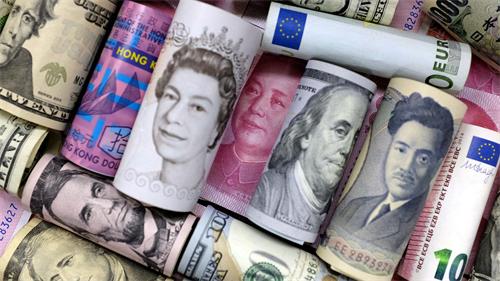Dollar Dominance Erodes: Asia’s Central Banks Diversify Reserves

The structure of global currency reserves is shifting in significant ways. Once upon a time, the dominance of the U.S. dollar was virtually unshakable—nearly every central bank in the world considered it the cornerstone of their foreign exchange reserves. However, that landscape is now shifting. A wave of "de-dollarization," driven by geopolitical tensions, U.S. policy unpredictability, and the rise of regional financial cooperation, is quietly unfolding across Asia.
The dollar's longstanding reign as the world's primary reserve currency was not solely due to the size of the U.S. economy. More importantly, the U.S. served as a stabilizing force in global economic governance. It led international institutions, set trade rules, and promoted global economic integration through multilateral cooperation. For many nations, holding dollar assets was a vote of confidence in the international order.
But in recent years, that confidence has begun to erode. The U.S. has increasingly acted unilaterally—exiting climate agreements, abandoning the TPP, and wielding sanctions indiscriminately—thereby depleting trust in the dollar. Countries are now awakening to the risks of placing all their eggs in one currency basket.
The tipping point came in 2022, when the U.S. froze Russia's dollar reserves following the outbreak of the Russia-Ukraine war. That act was a wake-up call for many central banks: dollar reserves are not absolutely safe. If a country's political stance clashes with U.S. interests, its financial assets could be weaponized. Consequently, central banks have started to rethink their strategies—should they diversify risk?
IMF Data Reflects the Shift: Dollar Share Hits 30-Year Low
De-dollarization is no longer just political rhetoric—it’s visible in the data. According to the IMF, the U.S. dollar’s share of global foreign exchange reserves has fallen to 57.8%, the lowest level since 1994. In just the past ten years, the dollar’s share has shrunk by 7.3 percentage points, marking a noticeable retreat from its once-dominant position.
Meanwhile, the share of non-dollar currencies in global reserves has gradually increased. The yen (5.8%), pound sterling (4.7%), Canadian dollar (2.8%), Chinese yuan (2.2%), and Australian dollar (2.1%) are all expanding their presence. While none of these currencies yet pose a direct challenge to the dollar’s supremacy, the trend toward diversification is unmistakable.
Of particular note is the yuan, which has surpassed 2% of global reserves and is playing an increasingly important role in regional cooperation across Asia.
Asia’s Central Banks Seek Alternatives: Won, Yuan, and SGD Gain Traction
Asian nations are at the forefront of the reserve diversification trend. Over the past three decades, Asia’s central banks have amassed over $2.5 trillion in foreign exchange reserves, once serving as a stabilizing anchor for dollar hegemony. Now, those reserves are being reallocated—posing a real challenge to the dollar’s dominance.
Three currencies stand out in this de-dollarization wave: the South Korean won, Singapore dollar, and Chinese yuan.
- South Korean Won: South Korea is expected to be included in the FTSE World Government Bond Index (WGBI) by 2025, which would prompt global central banks to increase their holdings of won-denominated assets.
- Singapore Dollar: Backed by a AAA credit rating, Singapore’s stable financial system and transparent markets make it an ideal candidate for risk diversification.
- Chinese Yuan: As the world’s largest trading nation, China’s yuan enjoys natural liquidity advantages and is increasingly used in bilateral settlements under the Belt and Road Initiative and regional trade frameworks.
Regional Financial Cooperation Reshapes Currency Landscape: ASEAN Starts to Break Free
In May 2025, ASEAN and the “10+3” countries (China, Japan, South Korea) issued a landmark joint statement during a finance ministers’ meeting. While it stopped short of explicitly calling for a break from the dollar, its policy direction was clear: reduce dollar dependence and boost regional currencies’ resilience.
Key measures include:
- Increasing the emergency lending pool—decoupled from the IMF—to $240 billion, with member countries contributing in non-dollar currencies such as yuan and yen.
- Introducing blockchain-based cross-border payment systems for real-time “T+0” settlements, bypassing the SWIFT network.
- Prioritizing the use of regional currencies for trade and financial crisis response within the bloc.
Several Southeast Asian countries are already putting these policies into practice:
- Malaysia will switch to local currency settlements for all trade with China and India from September 2025.
- Indonesia has raised the yuan’s share in its reserves to 12%.
- Thailand’s central bank has launched a pilot for cross-border exchanges between the digital baht and digital yuan.
These efforts are already yielding results. By 2024, the share of dollar-denominated trade within ASEAN fell from 68% to 52%, while yuan settlements rose above 28%. Clearly, a regional monetary network increasingly independent of the dollar is taking shape.
Toward a Multipolar Currency System
While the dollar’s supremacy is far from over, its irreplaceability is waning. The future of the international monetary system may be multipolar—comprising the euro, yuan, gold, and even digital currencies as a new basket of reserve assets.
This trend reflects a broader geopolitical shift. Nations like China, India, and Russia are seeking greater influence on the global stage, and building their own financial clout is a critical step in that direction.
Technology may also accelerate this transition. The development of central bank digital currencies (CBDCs) could bypass traditional clearing systems and establish new cross-border payment networks—further weakening the dollar’s grip on global settlements.
Consensus Elusive, Western Pushback Expected
Still, the road to de-dollarization won’t be smooth. Economic disparities among Asian countries remain vast—Singapore’s per capita GDP exceeds $65,000, while Myanmar’s is under $1,300. Crafting regional financial systems that align with the diverse priorities of each nation remains a complex and challenging endeavor.
Moreover, the U.S. is unlikely to relinquish its monetary dominance without resistance. In the future, we may see a strengthened U.S.-Europe alliance using stricter regulations and market rules to preserve the “dollar-euro” axis and squeeze out competing currencies.
The dollar remains powerful, but its unchallenged supremacy is quietly fading. In Asia, central banks are methodically reshaping the global monetary order. Their goal isn’t to overthrow the dollar but to build a more balanced and resilient reserve system. The future of global finance may not be a dollar empire—but rather a web of diverse currencies connecting East and West.



